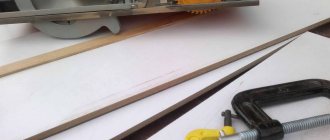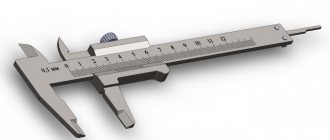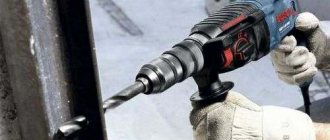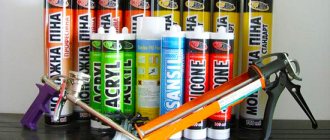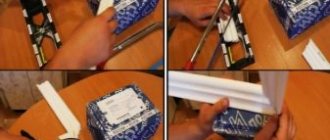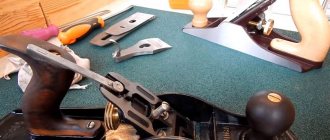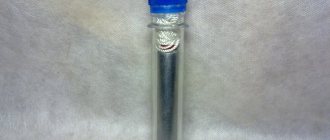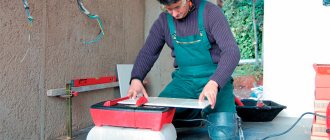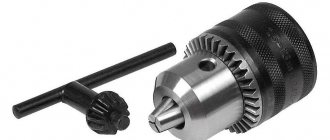A jigsaw is a tool for cutting parts. It can be used to make curved cuts in sheets of plywood, wood/metal objects and plastic. Using the tool, the master will be able to cut products in the shape of a star, triangles, circles, etc. Below you can familiarize yourself with the methods of working with this power tool, understand how to make cuts without chipping on different materials and learn how to cut smoothly with a jigsaw.
How clear the edges of the products and smooth cutting lines will be depends on the serviceability of the jigsaw and the experience of the craftsman
In what cases is a precise cut needed?
During sawing or at the time of creating a figured cut, the master strives to make the cuts even. Precise cutting is necessary in cases where it is required:
- make minimal tolerances for deviations;
- achieve tight abutment of mating surfaces;
- create a minimum gap;
- achieve an attractive appearance of cutting lines and parts.
Before you start working with the tool, you should familiarize yourself with information on how to cut smoothly with a jigsaw.
Characteristics affecting cutting accuracy
Certain parameters can influence the nature of the cut. When choosing a tool, you should pay attention to:
- Power level that affects the speed and depth of the cut. High-power units allow you to avoid vibrations and bending of the saw when working with any material.
- The number of revolutions that affects the cutting speed. Experts recommend giving preference to a high stroke rate if there is a need to cut soft wood. It is advisable to use low stroke rates for working with steel.
- Soft start, allowing the cutting operation to be performed smoothly and without jerking.
- Tool weight. A unit with increased weight often moves to another corner during operation.
- Possibility of adjusting speed. Using this function, the master will be able to select the cutting mode, taking into account the characteristics of the workpiece material.
- Maintaining speed under load. The stable movement of the cutting unit contributes to the creation of an even sawing seam. This eliminates the risk of chipping or leaving the trajectory.
- Airflow direction. The air flow blows across the cutting area, cools the engine and sweeps away sawdust. This improves the visibility of the cutting point.
Important! To increase visual control over the direction of the cut, it is recommended to use illumination of the work area.
To achieve the most accurate cutting, the master must maintain the direction in one plane
How to set up a jigsaw for a straight saw
How to cut material evenly with a jigsaw? Before starting carpentry work, you should check the serviceability of the unit. You will also need to check the files.
If the cutting blade is in good condition, the peaks of the teeth will be sharp. To achieve the most even cut and prevent vibration during work, it is advisable to place the entire lower part of the tool on the surface of the workpiece.
In order to avoid chipping and smoothly saw off soft wood workpieces, you need to adjust the speed (select the highest) and activate the pendulum function. When working with laminated chipboard, it is recommended to turn off the pendulum.
Advice! If you place pieces of laminated chipboard on the workpieces, you can prevent the appearance of chips on the material being cut.
Marking the cut line
How to saw with a jigsaw to cut the workpiece straight? This question interests many craftsmen involved in carpentry. In this situation, experts recommend marking a cutting line and securely fixing the material to the surface. When working with long canvases, you can use even slats as guides. Clamps are perfect for fixing.
Step-by-step process for marking a cut line:
- Before cutting the workpiece evenly with a jigsaw, you need to make markings on the material using a ruler.
- The required distance will need to be measured on both sides. The marks are connected, thereby forming a cutting line. If there is a need to create a curly line, you must first draw it on paper and only then transfer it to the material to be cut, using carbon paper.
- The markings are applied to the surface with a dark marker.
- Cutting the workpiece begins with drilling holes in the central part.
- During work, the blade should be directed from the center to the marking line. Only after this can the workpiece be cut around the perimeter of the circle.
Advice! You should not lean on the jigsaw during work, trying to increase the pressure on the material and quickly cut the workpiece.
When choosing the length of the file, it is necessary to take into account the thickness of the material.
Cutting technology
They begin sawing after securing the workpiece and applying markings. To do this, you need to turn on the jigsaw, set the maximum speed level and adjust the pendulum stroke by setting it to number 1.
You need to bring the file to the marking line, press the side of the platform against the guide and start working. When moving the jigsaw forward, you need to monitor the location of the platform. Do not deviate from the guide. When there are a few centimeters left to the end of the canvas, you need to carefully hold the free edge, avoiding breaking. At this point the process can be considered complete. To prevent the cut from turning out crooked, it is worth remembering a number of nuances:
- During operation, do not press too hard on the electric jigsaw, otherwise the file will break;
- when cutting a steel sheet, you need to choose a tool with maximum power and work at high speed - when heated, the steel softens and becomes more pliable;
- When processing plastic, laminate, organic glass or stainless steel, it is necessary to provide additional cooling for the file and periodically take breaks so that the tool has time to cool down;
- to prevent the plastic from melting during processing, it is necessary to set the minimum speed with a frequency of 1000 rpm;
- the figured cut will be smooth if you choose a narrow file with small teeth;
- After finishing the work, the electrical device should be cleaned of sawdust and placed in a special case.
Professional builders advise adhering to certain rules to help avoid mistakes that will not be easy to correct.
When choosing a file, you need to start from the material you are working with: plastic, thin or thick metal, plywood, solid wood. You should prepare in advance all additional items that may be needed during the cutting, marking and fastening process. Particular attention should be paid to fixing the material to the surface.
Note! To avoid defects, the canvas should be positioned face down.
It is best to try the sawing technique in advance and practice cutting with a jigsaw on unnecessary workpieces, because a crooked line will be difficult to correct. Safety precautions should not be neglected; you should use safety glasses and wear gloves when sawing.
If these recommendations are followed, the process of cutting parts should not be accompanied by unforeseen difficulties.
Methods of working with a jigsaw without chipping on different materials
Using a jigsaw you can process a large number of products (wood, metal, tin, plastic). When working with each type of material, you need to follow the recommendations of specialists and adjust the tool correctly, changing the pressure force, stroke frequency and smooth movement of the unit. Below you can find the answer to the question of how to properly cut various materials with a jigsaw.
How to cut metal
The teeth of the saw for cutting metal sheets should be small. The recommended pitch of the teeth is within 1-2 mm. The pendulum mode on the unit is turned off, the stroke rate is set to the lowest level.
Do not lean on the tool while sawing metal. It's worth moving smoothly. The cutting line on the pre-fixed blade is placed as close as possible to the support.
Advice! To prevent the jigsaw from overheating, it is recommended to take short breaks during operation.
How to cut wood, chipboard, plywood
To work with chipboard and wooden blocks, you should choose saws with medium teeth. The step interval should reach 3-4 mm. The stroke frequency is set to the maximum value. If there is a need to increase the speed of cutting the board, you can turn on the pendulum function.
To avoid damage, it is best to saw the blade from the back side. During operation, the tool is pressed against wood/plywood/chipboard. You need to move slowly.
When sawing wooden materials, you cannot push the tool; it must move independently along the workpiece
How to cut metal tiles
How to make an even cut with a jigsaw on metal tiles? If you are cutting short pieces of this material, it is worth considering that against the backdrop of the reciprocating movements of the unit, there may be a slight straightening of irregularities in the areas where the sheet makes a wave.
The length of the saw for sawing metal tiles must be at least 11 cm. It is advisable to use jigsaws with rubberized guides, which will make it possible not to tear off the paint from the surface of the sheet at the cut points.
How to cut plexiglass, plastic
A file for working with plastic and plexiglass at home should have small teeth. To ensure the smoothest possible cut, experts advise setting the pendulum function to the lowest setting. The recommended stroke rate is less than 40% of the maximum permissible value.
How to cut ceramics, porcelain tiles
To cut a ceramic product, you will need carbide files, but you can only work with porcelain stoneware using diamond files. To make a straight cut, you should use wide blades with carbide tips. If you can’t make holes with a jigsaw, you should use special pliers. The pendulum turns off. During work, it is unacceptable to push the tool.
How to cut laminate
In order to cut holes on the laminate, you will need to use reverse cut files. If the master has only ordinary files in his arsenal, it is better to carry out cutting work from the back side of the blade.
The stroke frequency can be set to the maximum permissible value. To avoid chipping, it is best to turn off the pendulum mode. During work, it is permissible to lightly press the power tool against the blade.
When sawing porcelain stoneware, it is worth installing a plastic pad on the sole of the tool.
Useful information
Application of adhesive tape
The fact that we cut smoothly with a jigsaw does not always give the desired result. Adhesive tape, for example, even ordinary tape, protects the back side of the material. Tape should be glued to the cut line, which will protect the processed fabric from tearing off large elements. Masking tape cannot be considered a sufficiently effective option for preserving material when cutting with an electric jigsaw, because the strength indicator is very low. It is best to use a fairly wide reinforced or aluminum fiberglass tape (each side of the cut on the material should be covered by at least 15 cm). Moreover, the adhesive tape should be pressed with a dry cloth to eliminate the risk of wrinkles.
Reworking the jigsaw sole
When setting up an electric jigsaw, you first need to check that the blade is perpendicular, because sometimes it is not easy to fix the clamp. Experts often modify the sole of the tool, namely, reduce the gap between the pressure pad and the leg. This will help eliminate “breakage” of the crust in the layers of material on top.
Please note that when using overlays, every novice craftsman must remember that they should not scratch the surface of the part. In this case, they should be replaced every 5 meters of cutting. Zero clearance can be obtained by attaching the cover plate to the support leg of an electric jigsaw.
The pad has only a narrow slot that fits tightly to the cutting element. For this reason, even a weak feed of the teeth can cut off small chips, and not turn out the chips of the top layer. The highest quality linings, which are guaranteed to last you as long as possible, are usually made of fiberglass, sheet plastic or metal sheets.
Making a clean cut
In most cases of material processing, the chip size is reduced to 0.5 mm. Such minor imperfections are practically not noticeable, and they can be removed by chamfering with sandpaper or covering up the chips with a correction pencil. You can also sand the end with sandpaper or cut through the top of the surface with a utility knife. To begin, you will need to make two cuts with a depth of 0.5 mm on both sides of the part, and also indicate the thickness. Mark two grooves along the edges of the cut, which can be made using an oblique segment or shoe knife (for uncoated wood material, or for chipboard), or using a pobedite cutter and a sharp blade (for laminate).
Correcting existing chips
Cutting material with an electric jigsaw and avoiding chipping is an almost impossible task. You can do this - cut the part with an electric jigsaw with a small allowance (about 0.2 cm), and then mill or grind off the allowance with a belt sander. During milling, the edge is cleaner than when working with a grinder. As a rule, material is milled on a tire that is made by hand (modeled on a tire from a circular saw). Spiral cutters help improve the quality of milling, and you should prepare them (two pieces).
If you want only the front side to be clean, then you need to use the simplest two-flute cutter. If both clean sides are required, use a four-flute router bit with two main flaps running to the left and two scoring flaps running to the right. In this case, it will turn out that when cutting the material, the upper branches will press the material down, and the lower ones will pull it up. This will prevent the formation of chips on the edge.
Features of working with hand tools
It is more difficult to work with a hand tool, but this particular jigsaw will help the craftsman out perfectly in cases where he urgently needs to make a piece of furniture, but there is no electricity. Sawing with a hand jigsaw is a rather labor-intensive process. The workpiece is securely fixed on the stand.
You need to cut the material starting from the center. To do this, the master drills a hole and only after that the cutting begins. Do not cut too close to the contour to prevent chipping.
Advice! The file should be secured as firmly as possible in the fixation area.
Final stage
In the last step you need to use another tool. You will need a spray or file, sandpaper, GOI board, adhesive tape and a decorative duralumin corner.
First of all, you need to polish the wood. To do this, you can use a spray or a file to remove the excess. Then use a sander or regular sandpaper (no sanding) to keep the wood looking good. It is recommended that you do this work even if you don't intend to do anything else afterwards. Due to the torn elements of the wood, the material will attract moisture much faster, which will cause faster wear of the material.
READ Replacing the fuel hose on a Husqvarna 450 chainsaw
Having restored the tree to normal, it is necessary to bring the plastic to the same condition. Usually it is enough to use special polishes. But if this is not available, you should not buy a new one, because you will need very little of this tool to finish one tabletop, and then throw away the AL-KO varnish, which is not economical.
The ideal option for plastic recycling is GOI paste. It is available in almost every home, and is a completely versatile tool and quite effective.
Even if the cut was successful and of high quality grinding, it is better to play on it safely so that even small millimeters do not make themselves felt in the future. Therefore, for finishing it is recommended to use a special furniture corner made of duralumin. It needs to be secured in place until the appearance is neat.
Why does a jigsaw cut crookedly?
In some cases, the craftsman may end up with a crooked cut. This kind of trouble arises due to:
- using a dull file;
- lack of marking line;
- too much pressure on the tool during work.
When working with materials that are too thick, it is difficult to achieve an even cut.
Troubleshooting solutions
To get an acceptable result, you need to be patient and work with the tool correctly. Don't put too much pressure on it or push it forward. This will only worsen the quality of sawing and cause chips to appear on the material. It is important to apply a marking line to the workpiece.
Sawing metal panels, wooden tabletops and other products requires a device with a well-sharpened saw blade.
Electric hacksaw
If you need to cut a round-shaped part and saw a round hole in the workpiece, then an electric hacksaw is the most suitable tool. With its help, you will save effort and time, since such a saw has great advantages over a manual one. Thus, the blade of the electric hacksaw is narrower, which provides increased maneuverability. Further, it has replaceable blades with different teeth, which allows you to process workpieces of any type, that is, wood, plywood, chipboard (it is no coincidence that the tool is also called a jigsaw).
To cut a section inside the workpiece, a hole is first drilled for a hand saw. But if you have an electric hacksaw, then this is not necessary. The tool is brought to the workpiece with a slight tilt forward and turned on in this position. The saw will cut the hole itself. Just don’t put too much pressure on the body - this can lead to breakage of the saw blade.
Lead in a circle
This device, simple in design, makes cutting out round holes or arcs much easier. It is enough to mark the center of the circle on the workpiece, fasten the device along the mark and connect the rod coming from it with an electric hacksaw. The divisions on the rod help set the saw blade at the required distance from the center of the circle. As a result, without preliminary marking, you can cut a circle or saw an arc with a radius of 5 to 20 cm.
The device (more precisely, its “sole”) is attached to the surface of the workpiece with screws. They should be well tightened. If the fastening is not rigid and starts to wobble, then an even circle will not work.
Suitable for lefties too
Left-handers can also use the device, since the guide rod is attached to the movable unit both on the left and on the right. So cut at your own discretion - clockwise or counterclockwise.
Using such a device, you can cut a round hole with a diameter of 10 to 40 cm in the workpiece without preliminary marking.
Mistakes when working with a jigsaw
If the carpentry work did not bring an acceptable result, it is worth considering how correctly the sawing procedure was carried out and whether all conditions were met.
Among the main mistakes that arise when working with a jigsaw, it is worth highlighting:
- Lack of experience with the device. In this case, only practice can help.
- Insufficiently reliable fixation of the material. When trying to cut a workpiece, the sheet begins to move out of place, which causes a crooked cut.
- Cutting too quickly.
- Using a homemade device. If you cut material with such a tool, it will be difficult for the master to achieve a good result.
- The use of a heavy unit. Against the background of a significant mass, the tool begins to move to the side during carpentry work.
Crooked cuts can occur when a craftsman uses a faulty tool.
It is important to check the functionality of the jigsaw before cutting.
When starting to cut any material, it is important to familiarize yourself with information on how to set up a jigsaw for a straight saw. This will make it possible to make a workpiece with the correct geometric shape and attractive appearance. To prevent thin sheets from deforming during work, you can use a backing. By using life hacks when working with a jigsaw, you can learn how to use the tool professionally.
Chipboard and the nuances of its processing
You can use a circular saw to cut the tabletop without swarfing.
To work you will need:
- laminated chipboard;
- Blade;
- Puzzles;
- Regular puzzle
In practice, chipboard only began to be used in 1940 in the United States, but after a very short time, popularity spread throughout the world, leading to the emergence of all sorts of varieties. The most popular variety has become chipboard, which is not only a product of pressing sawdust with glue under high temperature, but also additional physical and chemical protection in the form of melamine film.
When cutting simple chipboard, no difficulties can arise, but with chipboard everything is much more complicated. Most often, the manufacturer covers the table with HPL laminate, which further complicates the process. Coatings can vary greatly in their properties, but they are always polymer, so they have the same nuances when processed.
The process itself is quite simple and can be described step by step:
- Using a sharpened blade, a groove 2-3 mm deep is made. If there is a polymer coating of any kind, the blade must first be heated and used immediately. When cold steel is pressed against hard plastic, even with very serious sharpening, microcracks will occur, which is advisable to avoid;
- Using a jigsaw, slowly and carefully adjusting the direction, a cut is made. If there are places where the direction changes, it is better to use a manual jigsaw or find the thinnest nail file in the electric equivalent (inconvenient, but sometimes necessary).
READ Carburetor Tuning for Stihl 361 Chainsaw
Final cutting steps
Circular saw device.
For this step you will need:
- Scatter or file;
- Sandpaper;
- Insert GOI;
- Scotch;
- Decorative corner made of duralumin.
Everything here is quite simple, but you will not need to use millimeter precision, and each stage is performed in several variations.
First you need to polish the wood. To do this, first use a spray (file) that removes excess. Then using a sander (zero sandpaper) gives the wood a nice finish. This stage is necessary even in cases where nothing is planned to be done after it. Uprooted wood elements remove moisture much faster, causing wear and tear to occur at an incredible rate.
Once the wood is returned to normal condition, the plastic must be restored to the same condition. Special polishes are usually sufficient, but finding them in retail is not always easy. In addition, there is another complication. You only need a small amount of grinding and AL-KO will throw away the rest. The ideal option is GOI paste, which is available in almost every home, and the instructions for its use allow you not to be afraid of future use.
Even with successful cutting and high-quality grinding, you need to ensure that even missed millimeters do not make themselves felt. To do this, you can use a special furniture decorative corner made of duralumin. The corner is fixed in place without spoiling the appearance.
Another expert tip: when cutting, you can use a guide tape with an adhesive layer that will prevent the blade from deviating from the route.
You should not be afraid to cut the tabletop yourself without shavings when it is really necessary, but if possible it is better to take it to the nearest workshop, where it will be done on special equipment very quickly and with the highest quality.
Source
